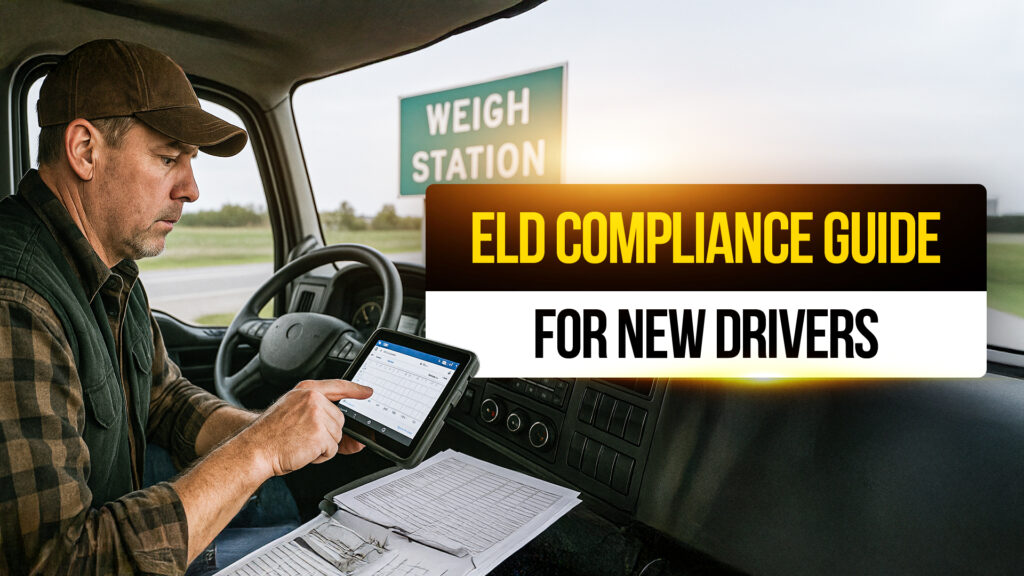
If you’re new behind the wheel with your CDL, you’ve probably heard a lot about ELDs, but you might still be wondering: What exactly do I need to do to stay compliant? This guide breaks it all down in plain terms. Whether you’re running OTR, regional, or local routes, understanding ELD (Electronic Logging Device) rules can save you from serious fines, and keep your trucking career on track.
Let’s clear up the confusion so you can focus on the road, not the red tape.
What’s Really Going On with ELDs?
The ELD mandate is a federal rule requiring most commercial drivers to use electronic devices to record their Hours of Service (HOS). This replaced paper logs and went into full effect in 2019.
The goal? Safety. By preventing driver fatigue and holding carriers accountable, the FMCSA (Federal Motor Carrier Safety Administration) hopes to reduce accidents caused by overworked drivers.
But for new drivers, adjusting to ELDs can feel overwhelming, especially if you’re not sure what’s required or how your device works.
🔗 Learn more about the ELD Rule directly from FMCSA.gov.
ELD Compliance: What You Need to Know
Here are the must-know basics to stay compliant:
📝 Required Info Your ELD Must Record:
- Date and time
- Vehicle and driver ID
- Location (automatically logged)
- Engine hours and mileage
- HOS status (On-Duty, Driving, Off-Duty, Sleeper)
📱 Daily Checklist for ELD Compliance:
- Log in at the start of your shift
- Change duty status correctly
- Certify your logs daily
- Keep 8 days of logs on hand (either on the device or printable)
🚓 During Roadside Inspections:
Be ready to show:
- ELD instruction manual
- Transfer or display logs
- Data transfer capability (email, USB, Bluetooth, etc.)
Common ELD Mistakes New Drivers Make
It’s easy to mess up your logs when you’re just starting out. Here’s what to avoid:
- Forgetting to switch duty status (example: staying “On-Duty” when you start driving)
- Driving without logging in
- Certifying logs late or not at all
- Not knowing how to transfer logs during an inspection
These slip-ups can lead to HOS violations, CSA points, and even out-of-service orders.
What It Means for Your Job (or Career Path)
Your compliance record matters, especially in your first year. A clean record makes it easier to land better-paying jobs, qualify for bonuses, and build trust with dispatch.
Depending on your route type and company setup, ELD usage might vary slightly. For example:
- Local drivers may qualify for short-haul exemptions (150 air-mile radius, back within 14 hours)
- Lease operators and owner-operators are fully responsible for their own compliance, so you’ll need to understand your ELD system inside and out.
If you’re ever unsure, ask your fleet manager or safety team. Being proactive shows you’re a pro.
🚛 Need Help Navigating All This?
If you’re stuck sorting through confusing carrier policies or stressed about your first audit, you’re not alone. Drivers 1st helps new drivers find jobs with real support, not just a recruiter who ghosts after orientation.
How to Stay ELD Compliant: 5 Quick Tips
- Know your HOS rules. Understand your limits: 11-hour drive time, 14-hour on-duty limit, 30-minute breaks, 70-hour workweek, etc.
- Learn your device. Watch videos or ask for a walkthrough before hitting the road.
- Log every duty status change. Accuracy protects you.
- Check your logs daily. Don’t wait for DOT to catch mistakes.
- Ask questions. Better to double-check than get dinged.
→ Talk to a Driver Advocate (No Pressure)
→ Search CDL Jobs Near You
Conclusion
ELD compliance might seem complicated at first, but once you get the hang of it, it becomes part of the routine. Staying sharp with your logs protects your license, your wallet, and your future behind the wheel.
Your CDL is your business. Make it work for you, not against you.
Whether you’re looking for better training or a more supportive carrier, Drivers 1st is here when you’re ready. No pressure, just better options.
For more updates and insights into the trucking world, stay tuned to Drivers1st.com!
